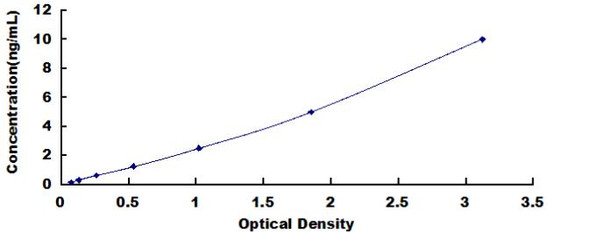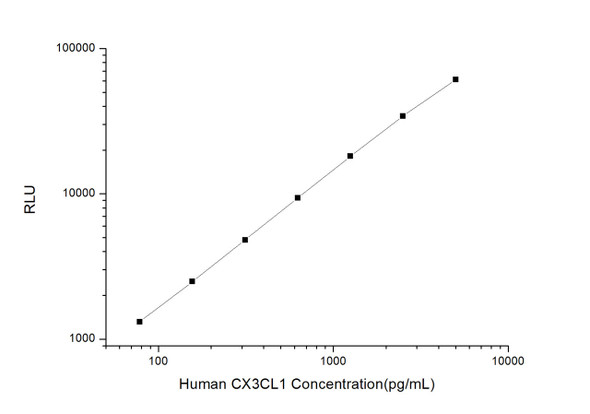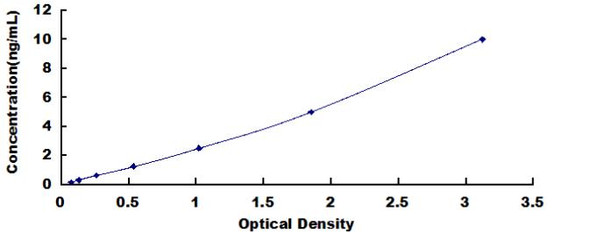Rat Signaling ELISA Kits 2
Rat CX3CL1 (Chemokine C-X3-C-Motif Ligand 1) CLIA Kit (RTES00213)
- SKU:
- RTES00213
- Product Type:
- ELISA Kit
- ELISA Type:
- CLIA Kit
- Size:
- 96 Assays
- Sensitivity:
- 18.75pg/mL
- Range:
- 31.25-2000pg/mL
- ELISA Type:
- Sandwich
- Synonyms:
- ABCD-3, C3Xkine, CXC3, CXC3C, NTN, NTT, SCYD1
- Reactivity:
- Rat
- Sample Type:
- Serum, plasma and other biological fluids
- Research Area:
- Cell Biology
Description
| Assay type: | Sandwich |
| Format: | 96T |
| Assay time: | 4.5h |
| Reactivity: | Rat |
| Detection method: | Chemiluminescence |
| Detection range: | 31.25-2000 pg/mL |
| Sensitivity: | 18.75 pg/mL |
| Sample volume: | 100µL |
| Sample type: | Serum, plasma and other biological fluids |
| Repeatability: | CV < 15% |
| Specificity: | This kit recognizes Rat CX3CL1 in samples. No significant cross-reactivity or interference between Rat CX3CL1 and analogues was observed. |
This kit uses Sandwich-CLIA as the method. The micro CLIA plate provided in this kit has been pre-coated with an antibody specific to Rat CX3CL1. Standards or samples are added to the appropriate micro CLIA plate wells and combined with the specific antibody. Then a biotinylated detection antibody specific for Rat CX3CL1 and Avidin-Horseradish Peroxidase (HRP) conjugate are added to each micro plate well successively and incubated. Free components are washed away. The substrate solution is added to each well. Only those wells that contain Rat CX3CL1, biotinylated detection antibody and Avidin-HRP conjugate will appear fluorescence. The Relative light unit (RLU) value is measured spectrophotometrically by the Chemiluminescence immunoassay analyzer. The RLU value is positively associated with the concentration of Rat CX3CL1. The concentration of Rat CX3CL1 in the samples can be calculated by comparing the RLU of the samples to the standard curve.
| UniProt Protein Function: | Acts as a ligand for both CX3CR1 and integrins. Binds to CX3CR1 and to integrins ITGAV:ITGB3 and ITGA4:ITGB1. Can activate integrins in both a CX3CR1-dependent and CX3CR1-independent manner. In the presence of CX3CR1, activates integrins by binding to the classical ligand-binding site (site 1) in integrins. In the absence of CX3CR1, binds to a second site (site 2) in integrins which is distinct from site 1 and enhances the binding of other integrin ligands to site 1. The soluble form is chemotactic for T-cells and monocytes, but not for neutrophils. The membrane-bound form promotes adhesion of those leukocytes to endothelial cells. May play a role in regulating leukocyte adhesion and migration processes at the endothelium. |
| NCBI Summary: | chemokine that binds its receptor CX3CR1; induces chemotaxis and increased intracellular calcium levels in microglia [RGD, Feb 2006] |
| UniProt Code: | O55145 |
| NCBI GenInfo Identifier: | 18266784 |
| NCBI Gene ID: | 89808 |
| NCBI Accession: | O55145. 3 |
| UniProt Related Accession: | O55145 |
| Molecular Weight: | 41,977 Da |
| NCBI Full Name: | Fractalkine |
| NCBI Synonym Full Names: | chemokine (C-X3-C motif) ligand 1 |
| NCBI Official Symbol: | Cx3cl1 |
| NCBI Official Synonym Symbols: | Cx3c; Scyd1 |
| NCBI Protein Information: | fractalkine; neurotactin; C-X3-C motif chemokine 1; small-inducible cytokine D1; CX3C membrane-anchored chemokine; small inducible cytokine subfamily D, 1 |
| UniProt Protein Name: | Fractalkine |
| UniProt Synonym Protein Names: | C-X3-C motif chemokine 1; CX3C membrane-anchored chemokine; Neurotactin; Small-inducible cytokine D1Cleaved into the following chain:Processed fractalkine |
| Protein Family: | Fractalkine |
| UniProt Gene Name: | Cx3cl1 |
| UniProt Entry Name: | X3CL1_RAT |
As the RLU values of the standard curve may vary according to the conditions of the actual assay performance (e. g. operator, pipetting technique, washing technique or temperature effects), the operator should establish a standard curve for each test. Typical standard curve and data is provided below for reference only.
| Concentration (pg/mL) | RLU | Average | Corrected |
| 2000 | 50272 61170 | 55721 | 55693 |
| 1000 | 22535 25413 | 23974 | 23946 |
| 500 | 11694 10370 | 11032 | 11004 |
| 250 | 4851 5737 | 5294 | 5266 |
| 125 | 2654 2562 | 2608 | 2580 |
| 62.5 | 1319 1303 | 1311 | 1283 |
| 31.25 | 649 699 | 674 | 646 |
| 0 | 27 29 | 28 | -- |
Precision
Intra-assay Precision (Precision within an assay): 3 samples with low, mid range and high level Rat CX3CL1 were tested 20 times on one plate, respectively.
Inter-assay Precision (Precision between assays): 3 samples with low, mid range and high level Rat CX3CL1 were tested on 3 different plates, 20 replicates in each plate.
| Intra-assay Precision | Inter-assay Precision | |||||
| Sample | 1 | 2 | 3 | 1 | 2 | 3 |
| n | 20 | 20 | 20 | 20 | 20 | 20 |
| Mean (pg/mL) | 106.10 | 261.11 | 698.69 | 98.92 | 250.55 | 757.52 |
| Standard deviation | 10.13 | 30.24 | 69.87 | 9.60 | 21.22 | 59.84 |
| C V (%) | 9.55 | 11.58 | 10.00 | 9.70 | 8.47 | 7.90 |
Recovery
The recovery of Rat CX3CL1 spiked at three different levels in samples throughout the range of the assay was evaluated in various matrices.
| Sample Type | Range (%) | Average Recovery (%) |
| Serum (n=5) | 91-104 | 97 |
| EDTA plasma (n=5) | 90-106 | 97 |
| Cell culture media (n=5) | 87-97 | 92 |
Linearity
Samples were spiked with high concentrations of Rat CX3CL1 and diluted with Reference Standard & Sample Diluent to produce samples with values within the range of the assay.
| Serum (n=5) | EDTA plasma (n=5) | Cell culture media (n=5) | ||
| 1:2 | Range (%) | 85-99 | 92-109 | 98-113 |
| Average (%) | 92 | 99 | 103 | |
| 1:4 | Range (%) | 87-101 | 92-103 | 97-111 |
| Average (%) | 94 | 98 | 103 | |
| 1:8 | Range (%) | 101-117 | 98-113 | 92-104 |
| Average (%) | 109 | 105 | 98 | |
| 1:16 | Range (%) | 95-109 | 102-118 | 88-100 |
| Average (%) | 102 | 108 | 93 |
An unopened kit can be stored at 4°C for 1 month. If the kit is not used within 1 month, store the items separately according to the following conditions once the kit is received.
| Item | Specifications | Storage |
| Micro CLIA Plate(Dismountable) | 8 wells ×12 strips | -20°C, 6 months |
| Reference Standard | 2 vials | |
| Concentrated Biotinylated Detection Ab (100×) | 1 vial, 120 µL | |
| Concentrated HRP Conjugate (100×) | 1 vial, 120 µL | -20°C(shading light), 6 months |
| Reference Standard & Sample Diluent | 1 vial, 20 mL | 4°C, 6 months |
| Biotinylated Detection Ab Diluent | 1 vial, 14 mL | |
| HRP Conjugate Diluent | 1 vial, 14 mL | |
| Concentrated Wash Buffer (25×) | 1 vial, 30 mL | |
| Substrate Reagent A | 1 vial, 5 mL | 4°C (shading light) |
| Substrate Reagent B | 1 vial, 5 mL | 4°C (shading light) |
| Plate Sealer | 5 pieces | |
| Product Description | 1 copy | |
| Certificate of Analysis | 1 copy |
- Set standard, test sample and control (zero) wells on the pre-coated plate and record theirpositions. It is recommended to measure each standard and sample in duplicate. Note: addall solutions to the bottom of the plate wells while avoiding contact with the well walls. Ensuresolutions do not foam when adding to the wells.
- Aliquot 100µl of standard solutions into the standard wells.
- Add 100µl of Sample / Standard dilution buffer into the control (zero) well.
- Add 100µl of properly diluted sample (serum, plasma, tissue homogenates and otherbiological fluids. ) into test sample wells.
- Cover the plate with the sealer provided in the kit and incubate for 90 min at 37°C.
- Aspirate the liquid from each well, do not wash. Immediately add 100µL of BiotinylatedDetection Ab working solution to each well. Cover the plate with a plate seal and gently mix. Incubate for 1 hour at 37°C.
- Aspirate or decant the solution from the plate and add 350µL of wash buffer to each welland incubate for 1-2 minutes at room temperature. Aspirate the solution from each well andclap the plate on absorbent filter paper to dry. Repeat this process 3 times. Note: a microplatewasher can be used in this step and other wash steps.
- Add 100µL of HRP Conjugate working solution to each well. Cover with a plate seal andincubate for 30 min at 37°C.
- Aspirate or decant the solution from each well. Repeat the wash process for five times asconducted in step 7.
- Add 100µL of Substrate mixture solution to each well. Cover with a new plate seal andincubate for no more than 5 min at 37°C. Protect the plate from light.
- Determine the RLU value of each well immediately.






